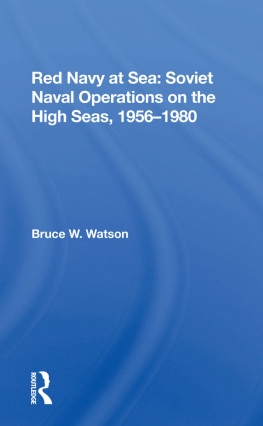The Soviet Navy
Also of Interest
Red Navy at Sea: Soviet Naval Operations on the High Seas, 1956-1980, Bruce W. Watson
The Armed Forces of the USSR, Third Edition, Revised and Updated, Harriet Fast Scott and William F. Scott
Available in hardcover and paperback.
Military Lessons of the Falkland Islands War: Views from the United States, edited by Bruce W. Watson and Peter M. Dunn
About the Book and Editors
Since Admiral Sergei G. Gorshkov was appointed to die office of commander in chief of the Soviet Navy in 1956, the Soviet Union has made a massive investment in naval construction, training, and operations. As a result, the Soviet Navy has grown from a coastal defense force to one of the world's two strongest navies. This book offers a detailed assessment of every major aspect of the Soviet Navy, from fleet structure and training facilities to command and control procedures and warfare and intelligence collection capabilities. In each case the analysis stresses the strengths and liabilities of the Soviet Navy and assesses implications for the West. The editors conclude that current trends indicate the Soviet Navy will play a major role in projecting Soviet military power in the developing world in the late 1980s and 1990s, a threat that the United States may find difficult to combat. Written by a team of academic researchers and naval analysts, the book provides a thorough understanding of the dimensions and implications of evolving Soviet naval power.
Naval Commander Bruce W. Watson is director of publications at the Defense Intelligence College and is the author of numerous military books, including Red Navy at Sea: Soviet Naval Operations on the High Seas, 1956-1980 (Westview, 1982). Susan M. Watson received her education at Trinity College and Georgetown University and is currently a free-lance editor and consultant.
The Soviet Navy
Strengths and Liabilities
edited by Bruce W. Watson and Susan M. Watson
First published 1986 by Westview Press, Inc.
Published 2019 by Routledge
52 Vanderbilt Avenue, New York, NY 10017
2 Park Square, Milton Park, Abingdon, Oxon OX14 4RN
Routledge is an imprint of the Taylor & Francis Group, an informa business
Copyright 1986 Taylor & Francis
All rights reserved. No part of this book may be reprinted or reproduced or utilised in any form or by any electronic, mechanical, or other means, now known or hereafter invented, including photocopying and recording, or in any information storage or retrieval system, without permission in writing from the publishers.
Notice:
Product or corporate names may be trademarks or registered trademarks, and are used only for identification and explanation without intent to infringe.
Library of Congress Cataloging in Publication Data
Main entry under title:
The Soviet Navy.
(Westview special studies on the Soviet Union and
Eastern Europe)
Bibliography: p.
Includes index.
1. Soviet Union. Voenno-morsko flotAddresses,
essays, lectures. I. Watson, Bruce W. II. Watson,
Susan M., 1943 III. Series.
VA573.S586 1985 359'.00947 84-27138
British Library Cataloguing in Publication Data
The Soviet navy: strengths and liabilities.
1. Union of Soviet Socialist Republics,
Voenno-morsko flot
I. Watson, Bruce W. II. Watson, Susan M.
359'.00947 VA573
ISBN 13: 978-0-367-29604-9 (hbk)
For Joseph Schiebel (19301976)
This book is dedicated to Joseph Schiebel by the authors and editors, all of whom have been associated with either Georgetown University or the Defense Intelligence College, where Professor Schiebel taught and served. Joe Schiebel began his tenure as director of the Russian Area Studies Program in 1966 and rapidly revised a lackluster program into one that was both highly respected and extremely responsive to Department of Defense needs. Likewise, he joined the faculty of the Defense Intelligence School in 1968 and was subsequently instrumental in formulating the school's proposal to establish a Master of Science in Strategic Intelligence. At both institutions, his extensive knowledge, high moral and academic standards, endless energy, and love for his students deeply moved them, prompting them to excel. Joe Schiebel suffered an untimely death in 1976; a great loss. Nonetheless, he influenced a large number of individuals who have gone on to publish, to teach, or to serve. In addition, many of his initiatives, such as the master's program at the Defense Intelligence College, were ultimately successful. Thus, we who owe so much to Joe Schiebel hope that this book repays in part his selfless efforts on our behalf.
Contents
, Peter Tsouras
, Tobias R. Philbin III
, Christine E. Miller and Robert G. Papp
, Michael J. O'Hara
, Robert E. McKeown and David Robinson
, Paul L. Pierce
, Mark A. Carolla, John P. Herries, and Curtis W. Good
, George Stuart and Linda Taylor
, Kenneth Vernoski
, Gael Donelan Tarleton
, Lawrence P. Larson
, Scott L. Nicholas
, John P. Herries
, Stephen T. Wesselhoff
, Richard Fisher
, Calland F. Carnes
, Michael A. Schoelwer
, Keith Allen
, Robert D. Wyman
, Michael Hritsik
, Frances Wright Norton
, Keith Allen
, Gerry S. Thomas
, Mark A. Carolla
, Kenneth Vernoski
, Brian Larson
, Peter Tsouras
, Charles W. Jones
, Bruce W. Watson and Susan M. Watson
Since Admiral Sergei G. Gorshkov's appointment as commander in chief in 1956, the Soviet Navy has made remarkable progress, advancing from little more than a coastal defense force to one of the world's two strongest navies. Dramatic developments in hardwareships, submarines, and aircrafthave been accompanied by equally illustrious advances in the navy's war-fighting capabilities and in naval operations that support Soviet foreign policy objectives. Such operations include port visits, responses to crises, and gaining access to port facilities. In fact, the navy has become the most important branch of the Soviet armed forces in respect to foreign policy matters, because it can be used as a diplomatic instrument in a more unobtrusive way than other military power. Navies operate on the high seas, use port facilities of other nations, make port visits, and accomplish many tasks which in and of themselves are not necessarily aggressive in nature. It is more difficult for ground and air forces to appear innocuous. Currently Soviet ballistic missile-equipped submarines patrol with weapons targeted against major U.S. cities, and other Soviet submarines stalk U.S. aircraft carriers and other naval forces on the high seas, while Soviet ships are visiting foreign ports or are present at overseas bases. These ships play a role in the superpower rivalry for influence around the world.













